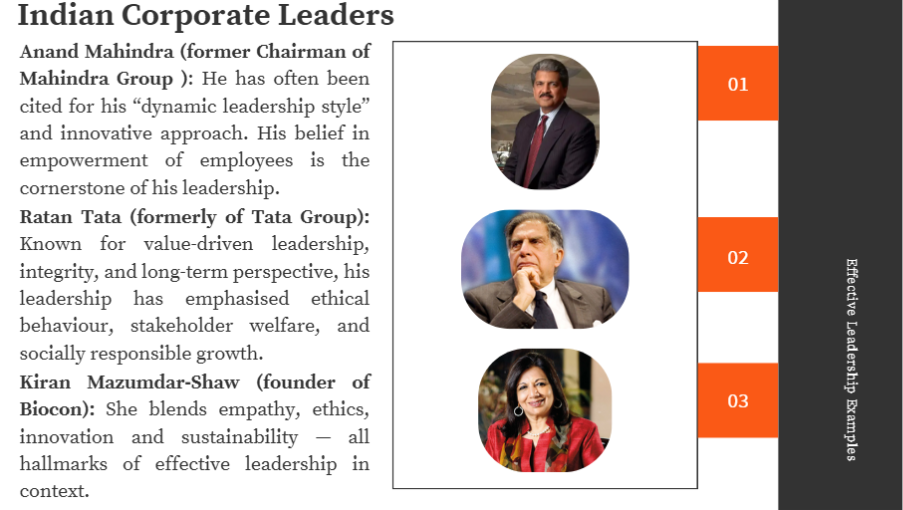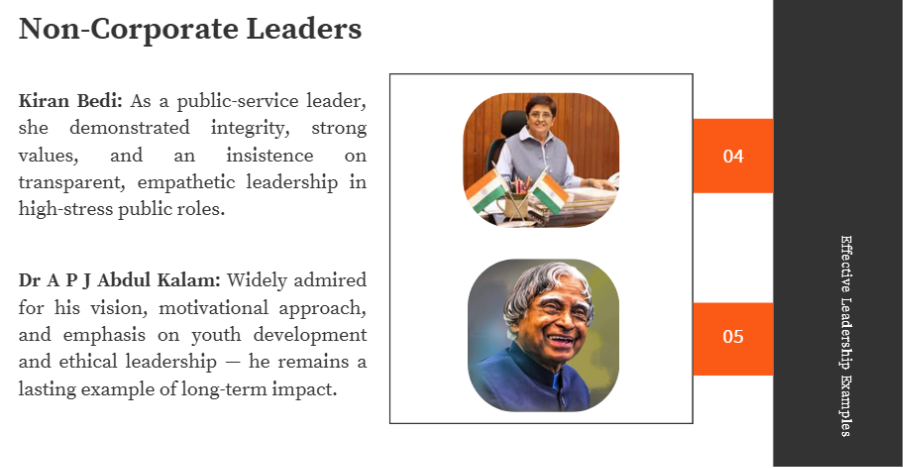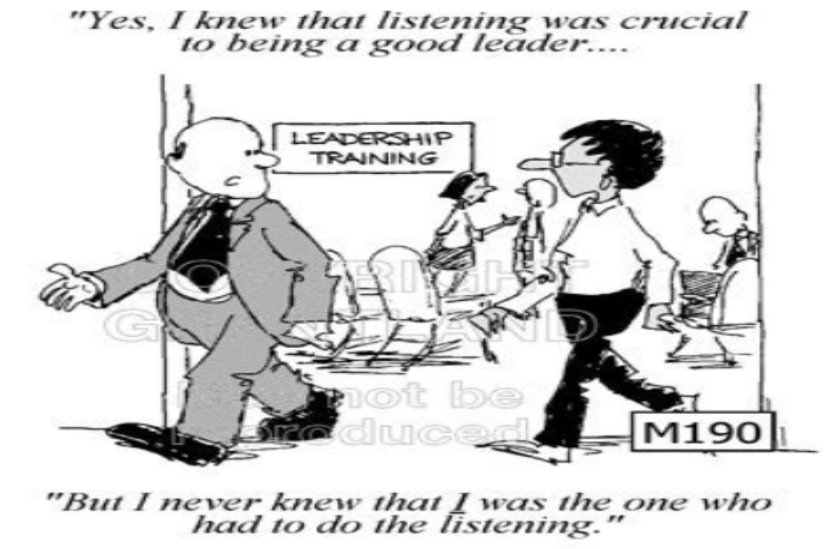Leadership and Team Effectiveness
Successful vs. Effective Leaders: What Sets Them Apart (with Real-World Examples)

.png)
Written by
Aarohi Parakh,
Psychologist and Content Writer

Reviewed by
Sanjana Sivaram,
Psychologist and Clinical Content Head

Introduction
Leadership is a term used widely in boardrooms and breakrooms alike, yet not all leaders are created equal. Two adjectives often surface in discussions on leadership: successful and effective. While they may sound synonymous, there are important distinctions — especially when one considers long-term team health, sustainable results, and a people-first leadership style.
In this article, we will explore what separates successful from effective leadership, illustrate the traits of both, provide real-world examples from India, and offer a path for leaders who want to shift from achieving short-term success to building lasting impact.
Who Is a Successful Leader?
Defining “Success” in Leadership
When we talk about a “successful leader”, we typically refer to someone who achieves tangible outcomes: meeting deadlines, promotions, revenue growth, market share, awards, and recognitions. A successful leader is judged by their ability to meet short-term organisational goals, often measured by external metrics such as profit margins, productivity, or cost savings.
For example: a CEO who doubles profits within two years, gains significant media recognition and advances rapidly in status — but perhaps leaves a high-turnover workforce, low morale, or a toxic work culture behind. That leader may be “successful” by traditional markers, yet whether they are truly effective is a different question.
Traits of a Successful Leader
Successful leaders often display the following characteristics:
- Goal-oriented: They set ambitious targets, track performance, and drive the team for results.
- Ambitious: They are keen to climb the corporate ladder, to take the next big step, to lead larger organisations or divisions.
- Strategic: They have a clear plan, a vision for growth, and make decisions to exploit opportunities.
- Performance-driven: They are focused on metrics, deadlines, output, and the bottom line.
These are important in many organisational contexts and often herald advancement and recognition.
Limitations of Success-Only Leadership
However, relying on success alone carries significant risks. Some of the limitations include:
- High burnout in teams: When the focus is purely on output and targets, teams may be pushed excessively, leading to fatigue and attrition.
- Lack of trust or long-term loyalty: If the leader’s style is transactional — “hit the numbers or else there would be consequences” — then team members may feel used rather than supported, undermining loyalty.
- Risk of short-term thinking: The pressure to deliver immediate results may encourage choices that undermine sustainability, like cost-cutting measures, sacrificing culture, and ignoring development for quick wins.
In short: being “successful” doesn’t necessarily equate to being “effective” — and it is the latter that promotes retention, growth, and people-first leadership.
Who Is an Effective Leader?
Defining “Effectiveness” in Leadership
Effective leadership is less about short-term accolades and more about long-term impact. It centres on team health, sustainable results, consistent values, and a balance between people and performance. Effective leaders are valued both internally (by their teams) and externally (by stakeholders), but most importantly, they embed a culture of trust, resilience and shared purpose. Effective leaders consistently exhibit core traits such as integrity, self-awareness, compassion, and communication. Moreover, effective leadership is increasingly recognised as something that can be developed rather than merely inherited.
Traits of an Effective Leader
An effective leader tends to demonstrate:
- Self-Awareness: They not only understand themselves but also recognise their strengths and weaknesses.
- Empathy: They understand and respond to the feelings, circumstances and motivations of their team members.
- Communication: They articulate vision clearly, listen actively, and encourage open dialogue.
- Values-based: Their decisions reflect a consistent ethical framework and they are trusted as much for how they lead as what they achieve.
- Consistency: They behave reliably, treat people fairly, keep commitments, and build credibility over time.
- Resilience: They have the ability not only to bounce back, but to respond adaptively to challenges. They take care of themselves and prioritise leading employee well-being.
In essence, effective leaders harness not just what needs to be done, but who is doing it and how. Research underscores that emotional intelligence, i.e. the ability to understand one’s own and others’ emotions, is a more powerful determinant of good leadership than technical competence or IQ.

The Impact of Effective Leadership
When leadership is truly effective rather than merely successful, the organisational benefits extend far beyond a one-time target. These include:
- High-performing teams: Teams that are engaged, motivated, and aligned with purpose outperform those that are merely managed.
- Lower attrition: A culture of trust and development fosters loyalty; people stay and grow.
- Innovation and trust: When team members feel safe, they experiment, speak up, collaborate and innovate — all of which feed sustainable success.
- Setting a good example for others: An effective leader knows that setting a good example is one of the best ways to inspire others.
- Improved Productivity: A team that is led effectively will be more productive, efficient, and successful overall.
- Decreases Mistakes: This is especially important in high-pressure environments where mistakes can have serious consequences. A leader needs to identify potential problems early and resolve them quickly.
- Increases Psychological Safety: An effective leader ensures that their teams can speak up freely and make mistakes, without the fear of punishment or retaliation.

Thus, effective leadership is best viewed not just as a fad or short-lived style, but as a strategic investment in long-term organisational vitality.
Key Differences Between Successful and Effective Leaders

Focus: Results vs. People and Results
Successful leaders prioritise targets and revenue that are measurable signs of achievement. Effective leaders balance results with people, investing in team growth and morale to sustain success in the long term.
Motivation: External vs. Internal Drivers
While recognition, promotions, or bonuses drive successful leaders, effective leaders find motivation in purpose and impact, measuring success by their team’s development and the organisation’s legacy.
Team Approach: Directive vs. Collaborative
Directive leaders lead top-down, giving clear instructions but limiting innovation. Effective leaders collaborate, value input, and create ownership — resulting in more engaged and creative teams.
Risk Profile: Overlooking Wellbeing vs. Balancing with Empathy
Success-focused leaders may push for short-term wins at the cost of team well-being. Effective leaders pursue ambitious goals while maintaining empathy, fostering trust and balance.
Examples in Practise
A performance-focused CEO might achieve rapid growth but struggle with attrition. In contrast, people-first leaders like Ratan Tata or Satya Nadella show that empathy and excellence can thrive together.
Examples of Effective Leadership in India
These leaders exemplify leadership in India that is not just about profit, but about people, purpose and legacy.

These examples show that effective leadership transcends context: corporate or public, Indian or global. The underlying themes remain the same: values, empathy, consistent application and sustainable results.

How to Grow from a Successful to an Effective Leader
Moving from success-driven leadership to effective leadership isn’t about abandoning ambition — it’s about expanding it. Actual effectiveness comes when leaders look inward, connect emotionally, and build environments where others can thrive.
Three key pillars support this shift: self-reflection, emotional intelligence, and psychological safety.
Practice Self-Reflection
Self-awareness is the first step on the path to effective leadership. Leaders who understand their values, biases, and impact on others are better equipped to lead authentically and adaptively.
- Regular journaling can be a powerful place to start. Writing down daily decisions, challenges, and emotional reactions can clarify patterns of thought and behaviour. Leaders like Satya Nadella of Microsoft have spoken about how reflective practices helped shift the company from a “know-it-all” to a “learn-it-all” culture — one grounded in curiosity and empathy.
- Another proven method is seeking 360° feedback. Unlike performance reviews that assess outcomes, this approach focuses on perceptions — how your leadership feels to those around you. Anonymous surveys or tools like the Center for Creative Leadership (CCL) Benchmarks® provide valuable insights into blind spots and relational strengths.
Research says that self-awareness is one of the top differentiators of effective leaders. Those who regularly engage in reflection and feedback cycles are not only more adaptable but also demonstrate greater emotional resilience and more accurate decision-making.
Self-knowledge is not indulgence — it’s infrastructure. It strengthens every leadership skill that follows.
Prioritise Emotional Intelligence (EI)
If self-awareness is the foundation of leadership, emotional intelligence is the bridge that connects leaders to people. EI enables leaders to engage not just with tasks, but with human experience.
- According to Daniel Goleman (1998), emotional intelligence consists of self-awareness, self-regulation, motivation, empathy, and social skills — all crucial for effective leadership. Further research published in the Harvard Business Review found that EI accounts for nearly 90% of the difference between high performers and their peers in leadership roles.
- Active listening is one of the most visible markers of EI in action. In practice, this means being fully present — asking clarifying questions and reflecting what you hear. Starbucks' former CEO, Howard Schultz, attributed much of his leadership style to listening tours with employees, saying, “Success is best when it’s shared.”
- Emotional regulation or staying composed under pressure is another crucial aspect. Imagine that a product launch fails. One leader may respond defensively by placing blame and acting urgently. Another could empathetically reset goals, invite lessons learnt, and acknowledge disappointment. The latter improves psychological safety and preserves morale.
During the COVID-19 crisis, Arne Sorenson, then CEO of Marriott, addressed employees in an emotional video acknowledging both financial challenges and human impact. His transparency and vulnerability earned global respect, illustrating that compassion can coexist with business realism.

Leaders who prioritise emotional intelligence don’t just manage people -they move them.
Build Psychological Safety
Even the most emotionally intelligent leader can falter if their teams feel unsafe to speak up or make mistakes. That’s where psychological safety — the belief that one won’t be punished for voicing ideas or errors — becomes critical.
The concept gained prominence through Google’s Project Aristotle, which found that psychological safety was the number one predictor of team performance. Teams that felt safe to take interpersonal risks were more creative, more collaborative, and more committed.
How to build it:
- Encourage openness: Invite questions, conflicting opinions, and feedback in meetings. When leaders respond to criticism with curiosity rather than defensiveness, they send a clear signal: you are safe here.
- Celebrate effort, not just success: For example, Pixar’s “Braintrust” sessions allow filmmakers to share unfinished ideas without fear of judgment. Feedback focuses on improving the work, not critiquing the creator.
- Model vulnerability: When a leader admits, “I don’t know” or “I was wrong,” they model humility and set the tone for authenticity. Such vulnerability correlates strongly with team learning and engagement.
Avoiding responsibility does not equate to psychological safety. It entails replacing trust with fear. People are more likely to freely share ideas, bounce back from setbacks more quickly, and remain fully committed to the organisation's mission when they feel safe.
The Takeaway
Effective leadership does not show up overnight; it’s cultivated through self-reflection, emotional intelligence, and a psychologically safe environment. Leaders like Ratan Tata, Satya Nadella, and APJ Kalam exemplify this balance, combining compassion with clarity, and results with respect.
In the end, success-driven leaders may deliver outcomes; effective leaders create ecosystems where outcomes sustain themselves — powered by motivated, trusted, and inspired people.
Common Myths About Effective Leadership
Even in forward-thinking workplaces, misconceptions about what makes a leader truly effective persist. Many equate effectiveness with being “nice,” “slow,” or “overly people-focused.” In reality, effective leadership strikes a deliberate balance — it’s about driving results through people, not at the cost of them. Let’s clear up a few common myths with some everyday workplace examples.
Myth 1: “You have to be nice all the time”:
Being effective doesn’t mean avoiding tough calls, it means handling them with fairness.
Example: Priya, a team lead, addresses repeated missed deadlines firmly but respectfully, focusing on accountability and solutions rather than blame. Her team performs better and trusts her more.
Reality: Effective leaders are not always “nice,” but they’re consistently fair and respectful.
Myth 2: “It’s about making everyone happy
Leaders aren’t there to please everyone; they’re there to create clarity and purpose.
Example: Arjun reassigns staff to a new project despite initial pushback. By explaining the rationale and supporting the change, he earns trust rather than universal approval.
Reality: It’s about trust and transparency, not popularity.
Myth 3: “Effectiveness is slower than success.”
Short-term wins can fade fast if people burn out
Example: Neha, a sales director, resists pushing her team to the point of exhaustion for short-term targets. Instead, she invests in skill-building and recognition. It takes longer to show results, but by year’s end, her team exceeds goals and has the lowest attrition rate.
Reality: Sustainable success always outlasts short-term results.
In short, effective leaders aren’t soft; they’re strategic, disciplined, and people-first, driving results that last.
FAQs
Q1. What makes a good leader effective?
An effective leader creates sustainable results while enabling team wellbeing and development. They balance performance with empathy, direction with collaboration and drive with trust.
Q2. Can someone be both successful and effective?
Absolutely yes. The most admired leaders balance both — they deliver results and cultivate a people-first culture. Success and effectiveness need not be mutually exclusive; in fact, together they lead to truly transformational leadership.
Q3. What’s more important: being successful or being effective?
In the short term, success may earn you recognition. But in the long run, being effective leads to sustainable success. Its effectiveness that builds legacy, retains talent, and creates organisations that thrive.
Further Reading & Resources
Want to strengthen your leadership toolkit? Explore our related articles:
- Management Skills – learn how to balance direction with empathy.
- Assertive Communication at Work – master clarity without conflict.
- Preventing Burnout – understand the organisational-level strategies managers adopt to prevent burnout in teams.
Want to grow into a more effective leader? Our trained counsellors at 1to1help can help you reflect, communicate better, and cultivate a people-first mindset. Begin your leadership journey today →here
Final Thoughts — Beyond Success: The True Measure of Leadership
In conclusion, the most influential leaders choose to be effective, striking a balance between performance and purpose, ambition and empathy, and results and respect, while many strive for the badge of "successful." Leadership that respects both the human element and the bottom line will always endure in a world that is changing quickly.
Let this serve as both a challenge and a guide: if you're leading today, consider whether you're creating something more substantial and long-lasting or merely meeting goals. Where your leadership legacy starts makes a difference.
References
- Forbes. (2020, March 21). Marriott’s CEO demonstrates truly authentic leadership in a remarkably emotional video. Forbes. https://www.forbes.com/sites/carminegallo/2020/03/21/marriotts-ceo-demonstrates-truly-authentic-leadership-in-a-remarkably-emotional-video/
- Goleman, D. (2004, January). What makes a leader? Harvard Business Review. https://hbr.org/2004/01/what-makes-a-leader
- Britannica. (n.d.). IQ. In Encyclopædia Britannica. Retrieved October 29, 2025, from https://www.britannica.com/science/IQ
- Center for Creative Leadership. (n.d.). The characteristics of a good leader. Retrieved October 29, 2025, from https://www.ccl.org/articles/leading-effectively-articles/characteristics-good-leader/
- Gallup. (n.d.). How to be a better leader. Retrieved October 29, 2025, from https://www.gallup.com/cliftonstrengths/en/356072/how-to-be-better-leader.aspx
- Harvard Business School Online. (n.d.). Characteristics of an effective leader. Retrieved October 29, 2025, from https://online.hbs.edu/blog/post/characteristics-of-an-effective-leader
- Harvard Business School Online. (n.d.). Emotional intelligence in leadership. Retrieved October 29, 2025, from https://online.hbs.edu/blog/post/emotional-intelligence-in-leadership
- Healthline. (n.d.). Fatigue: Symptoms, causes, and treatment. Retrieved October 29, 2025, from https://www.healthline.com/health/fatigue
- Investopedia. (n.d.). Attrition. Retrieved October 29, 2025, from https://www.investopedia.com/terms/a/attrition.asp
- Michael Page. (n.d.). Effective leader traits. Retrieved October 29, 2025, from https://www.michaelpage.co.in/advice/management-advice/leadership/effective-leader-traits
- Project Aristotle. (n.d.). Google’s Project Aristotle and psychological safety. PsychSafety.com. Retrieved October 29, 2025, from https://psychsafety.com/googles-project-aristotle/
- Program on Negotiation at Harvard Law School. (n.d.). Effective leadership. Retrieved October 29, 2025, from https://www.pon.harvard.edu/tag/effective-leadership/
- Siena Heights University. (n.d.). 10 reasons leadership is important in the workplace. Retrieved October 29, 2025, from https://www.sienaheights.edu/10-reasons-leadership-is-important-in-the-workplace/
- TechTarget. (n.d.). Signs of toxic workplace culture. Retrieved October 29, 2025, from https://www.techtarget.com/whatis/feature/Signs-of-toxic-workplace-culture
- The MBA Institute. (n.d.). Successful vs. effective leader. Retrieved October 29, 2025, from https://themba.institute/management-functions-and-organisational-processes/successful-vs-effective-leader/
- Walden University. (n.d.). What makes a good leader: Ten essential qualities to learn. Retrieved October 29, 2025, from https://www.waldenu.edu/programs/business/resource/what-makes-a-good-leader-ten-essential-qualities-to-learn










